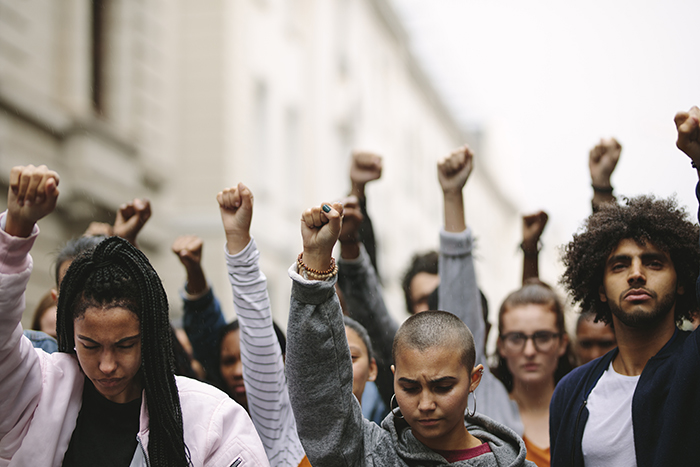The police have long been a reliable source for some
But it is time to reexamine that trust
Posted on August 03, 2020
 I can’t stop thinking about Manuel Ellis.
I can’t stop thinking about Manuel Ellis.
I keep wondering if it weren’t for the global uprising for racial justice in the wake of George Floyd’s killing by Minneapolis police, whether Ellis’ killing would have passed by mostly unnoticed — as so many have before him — with just the word of the police satisfying a not particularly curious public.
It’s high time for the public — and the media — to interrogate police statements more aggressively.
Tacoma police killed Ellis on March 3, but it wasn’t until early June that his case started to get attention. Initially, as is all too common, early stories reported just the Police Department’s narrative. Police said Ellis harassed a driver, struck their police car and “slam dunked” an officer to the ground. They attributed his actions to “excited delirium,” a term used by police to justify deadly force but described as “pseudoscience” by critics.
It wasn’t until mid-June that it was revealed that the Pierce County Sheriff’s Office investigating the case — supposedly to create investigatory independence — was at the scene of the killing as well. Video began to emerge that showed officers pummeling Ellis as he gasped, “I can’t breathe,” words now tragically familiar. The medical examiner ruled Ellis’ death a homicide from oxygen deprivation due to physical restraint.
Now under scrutiny by activists, the general public and the media, the governor directed the State Patrol to investigate the killing. The state attorney general is reviewing Ellis’ case, as well as 30 other police deadly force incidents.
If we have learned anything from the protest movement of the past two months, we should have at least learned what people of color and other marginalized people have said forever: You can’t uncritically trust “official” accounts when it comes to policing and protests.
Efforts to contest and control the Seattle protest narrative began in late May. As my colleague Danny Westneat wrote in early June, the Seattle police chief and mayor’s efforts to paint property destruction from the first days of the protests as the work of mostly white, outside agitators was not supported by facts.
Later, in mid-June, during the height of the media frenzy around the Capitol Hill Organized Protest (CHOP), an assistant Seattle police chief told the media that protesters were extorting local businesses within the CHOP for money. The claim was repeated by the police chief the next day and then reported by media around the world, including this paper.
The problem was, there turned out to be no police reports alleging extortion.
The source of the claim was a conservative blog citing unnamed police officers. The police walked back the claim, but the damage was done. The extortion claim became a key component in breathless reporting about lawlessness in CHOP by conservative media, resulting in President Trump calling out the governor and the mayor in a tweet to “Take back your city NOW. If you don’t do it, I will.”
The extortion story was one of many police storylines widely reported but unsubstantiated during the weeks of CHOP occupying Capitol Hill. Others included the police chief saying that “calls for [police] service have more than tripled,” during CHOP, which may have been an accidental misstatement but was nonetheless picked up widely in conservative media. Reporting by The Seattle Times showed that calls near the East Precinct actually dropped 31% in the first two weeks of June.
Seattle police also said in a tweet that “improvised explosives” were thrown at officers, but their tweeted photo of the device showed a candle.
Misinformation is not new. But the speed, ferocity and impact of misinformation that permeates coverage of the protest movement in Seattle and beyond is remarkable.
According to media intelligence firm Zignal Labs, of 873,000 pieces of George Floyd protest-related misinformation tracked, 575,800 were about antifa being responsible for riots and looting. This misinformation led to armed groups descending on cities and towns like Snohomish to “protect” them from antifa threats that never materialized.
The speed, ferocity and impact of misinformation that permeates coverage of the protest movement is remarkable”
Joan Donovan is research director of the Harvard Kennedy School’s Shorenstein Center on Media, Politics and Public Policy. She said the media need to do more to broaden their sources to include community members and not just rely on the official narratives.
“I think it’s really important,” Donovan said, “not just to print the press release, but to try to substantiate any of the claims of politicians and police and police unions in times of high social unrest, because the struggle over the narrative is a proxy war. It’s a proxy war between the protesters and the state.”
The media have long been complicit in the “police said” convention in crime reporting, but that practice is getting an overdue revisiting and reckoning, including in this newsroom. Police should not be exempt from the skepticism and rigor we apply to other sources of information. As I remember being taught as a budding journalist long, long ago, “If your mother says she loves you, check it out.”
The shift can’t come soon enough, as families like Manny Ellis’ have tried to get people to hear their calls for justice for years, and too few people have listened.
Naomi Ishisaka: nishisaka@seattletimes.com; on Twitter: @naomiishisaka. Naomi Ishisaka writes about race, culture and equity, through a social-justice lens. Her column appears weekly on Mondays.
SEE ALSO:
More Race Relations Articles
Sexual Bias Articles
Mental Health Articles
How Drugs and Alcohol Affect the Brain and Body
WA. Counselor Directory: find a therapist near you
How helpful is this web page to you?
(and how can we can improve this page for you?)
not helpful
very helpful
Other Articles
I am a Black Police Officer. Here is How to Change the System.
Yes, defund the police. But then re-fund them, better.
NEWPORT NEWS, Va. — When I entered the police force in Virginia in 1987, I was one of the few Black officers in my department. On my first day on patrol, I was paired with an experienced white officer.... read more
Lakewood officer who fatally shot driver in May was involved in 2013 shooting that led to record wrongful-death verdict
Said Joquin & Leonard Thomas
A Lakewood police officer who shot and killed a motorist during a traffic stop May 1 was also involved in the deadly shooting of a despondent Fife father in front of his 4-year-old son in 2013, resulting in... read more
SPD Deputy Chief Adrian Diaz vows to move department forward in wake of Carmen Best
After 16-year-old Fernando Esqueda was fatally shot in a drive-by shooting in April 2005, then-Seattle police Officer Adrian Diaz was assigned to work with young people and help develop youth programs at the... read more
Ahmaud Arbery
3 men indicted on murder charges in killing of Ahmaud Arbery
The fatal shooting of Ahmaud Arbery in Georgia has stoked a national uproar over race relations. No arrests were made for two months until video of the shooting surfaced. 3 men indicted on murder charges... read more
Investigate Tacoma police in Manuel Ellis death
Editorials
Tacoma and Pierce County authorities have a lot to answer for regarding the in-custody death of Manuel Ellis. This extends even beyond the need for rigorous investigation of every officer at the scene where... read more
Tucson police in turmoil after death of Latino man
The police chief of Tucson, Arizona, abruptly offered to resign on Wednesday while releasing a video in which a 27-year-old Latino man, Carlos Ingram Lopez, died in police custody two months ago. The vid... read more







